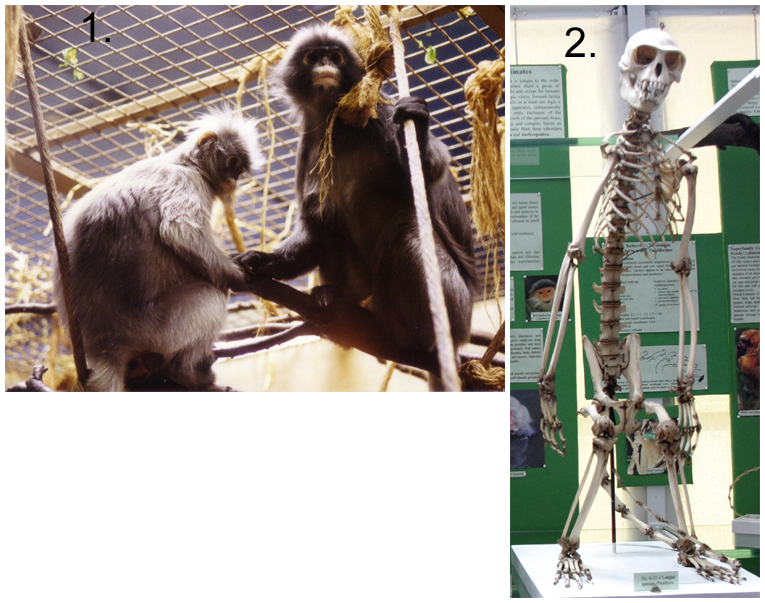
FAMILY CERCOPITHECIDAE
SUBFAMILY COLOBINAE
LEAF MONKEYS
The subfamily Colobinae contains 37 species of leaf-eating monkeys. Colobus monkeys, leaf monkeys, langurs, surelis, snub-nosed monkeys, doucs and the proboscis monkey are distinguished by the possession of a sacculated stomach in which leaves are digested by bacterial fermentation.
Colobids have small heads with broad faces and bold, well-separated, forward facing, eyes; their bodies are large and their limbs long. Their thumbs are insignificant - a general feature of animals that use their hands as hooks to grab branches as they leap through the trees in dense forest. Although an advantage in some ways, the loss of their thumbs is a disadvantage as they cannot manipulate food with their hands and have to take food from plants with their mouths.
Colobids feed on seeds, shoots, flowers, buds and fruit as well as leaves. They possess sacculated stomachs, in which bacterial fermentation breaks down the cellulose in the leaves and detoxifies compounds that supposedly protect seeds and leaves from herbivores. To help in consuming a diet of leaves they have deep jaws with heavy muscles for chewing leaves and large salivary glands. They have the typical dental formula of an Old World Monkey: I2/2; C1/1; P2/2; M3/3 = 32.
Colobids are diurnal monkeys with complex social structures, living in groups of one dominant male and many females or in mixed groups of many males and many females. In Africa, leaf monkeys are represented by the large number of species of colobus monkeys with very varied pelages. In Asia, leaf monkeys are represented by langurs in India, the Himalayas, Sri Lanka and China, by surelis in Borneo and Java, by snub-nosed monkeys in Tibet, China and the Far East, and by the proboscis monkey in Borneo.

1. A colobus monkey, Colobus guerera, leaping from tree to tree in the Ethiopian highlands.
2-4. Male proboscis monkey, Nasalis larvatus, feeding on leaves in a forest in Bako National Park in Sarawak, Borneo. The elongated, tongue-shaped and pendulous nose are features of the male, females have snub-noses. Photographs courtesy of J. Glendinning.

1. Semnopithecus obscurus, Spectacled or Dusky Leaf Monkeys, photographed at The Royal Zoological Society of Scotland.
2. Skeleton of Semnopithecus sp., a langur. Langurs are very mobile monkeys, they walk, leap, sit and squat. The skull shows the typical globular braincase and forward looking eyes of a monkey and the typical brow ridges of the genus Semnopithecus. The skeleton has typical monkey features: a long body with a narrow rib cage, long back and long distance from rib cage to pelvis, and a long tail. The skeleton also has the typical features of a leaf monkey: a small head, a large body and the short thumb. The separate ulna and radius, which can rotate over one another, and the separate tibia and fibula in the lower hind limb, which are primate features, are easy to see. This specimen is posed rather strangely as though it were squatting or sitting on an invisible support.






